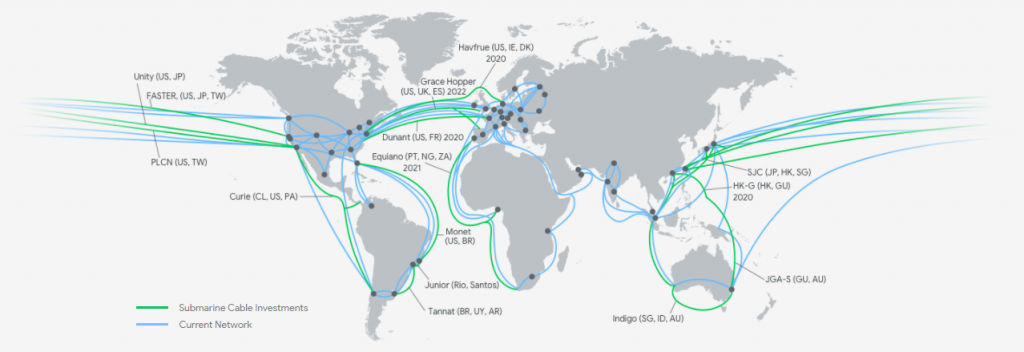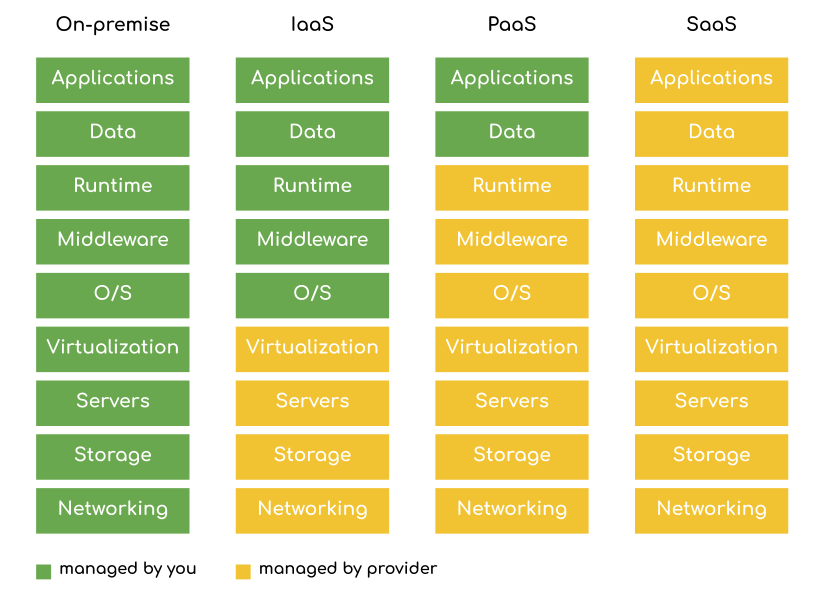Table of contents
Clouds are no longer just above our heads; they are with us in homes and offices. And it’s not a new type of stratocumulus but a cloud that was born on the ground – from thousands of servers and kilometres of wires. It’s called cloud computing and has little to do with the actual sky.
Let’s have a closer look at cloud technologies.
What are cloud technologies, and who delivers them?
A cloud is a set of interconnected servers. A server is a program or machine on which you can store and process data – texts, images, website files – and run applications or conduct advanced analysis. The servers can be connected via a private or a public network (i.e., the Internet).
The top providers in the cloud industry (e.g., Google, Amazon, Microsoft) have millions of servers placed in different locations. Thanks to that, you can use almost unlimited computing power or transfer information between distant data centres in seconds.

The map of Google Cloud network and data centre locations. Green – current connections, blue – investments in progress.
Machines run 24/7. Service providers take care of the proper condition – they conduct software updates, protect devices from flooding, burning, or burglary, and take care of the proper air humidity or temperature in the server room.
Cloud is not only disk space but a set of hundreds of services that can be used to develop a company or an application. You can operate in the cloud in three models – IaaS, PaaS, and SaaS (take it easy, we’ll explain these shortcuts in a moment). You have access to various virtual machine types, including high-memory and high-performance computing, BigData analytics services, out-of-the-box machine learning models, and more – there are hundreds of cloud services. They run on-demand and are billed due to usage level (or, in the SaaS model, for a monthly fee).
The definition of cloud computing
Straight to the point – cloud computing is a data processing model in which the user has access to resources and services belonging to the provider, e.g., computing power, disk space, cloud databases, BigData analysis, or artificial intelligence services. Resources are placed on the provider’s infrastructure, and the user can access them through a private or public network.
Private, public, hybrid, multi – types of computing clouds
There are four main types of computing clouds, depending on who maintains the network and with whom he shares the resources.
Private cloud
The private cloud is dedicated to one organization. The machines, internal network, services, and resources are owned by the company and maintained by an internal IT department or an external provider. The maintenance team can create and deploy various services, but it goes with additional time and cost consumption.
Public cloud
A public cloud is a solution in which machines and resources belong to an external provider – e.g., Google (Google Cloud Platform), Amazon (Amazon Web Services), or Alibaba (Alibaba Cloud). The owner of a public cloud gives access to the resources and hundreds of cloud services, such as virtual machines, data warehouses, cloud databases, machine learning and artificial intelligence models, BigData analysis services, or the Internet of Things platform. Services are fully scalable, run on demand and, in many cases, the fee is charged on a per-second or per-minute basis.
Hybrid cloud
A hybrid cloud combines a public cloud with a private cloud or an on-premise environment (i.e., on your physical server). A hybrid cloud allows you to store critical information or data under legal protection on your private solution while using ready-made public cloud services.
Multi-cloud
It’s a type of infrastructure that consists of two or more public clouds, e.g., Google Cloud Platform and Microsoft Azure used simultaneously.
IaaS, PaaS, SaaS – types of services in the cloud
As said earlier, you can choose between three models in which cloud services are served. They differ in which layers are maintained by the provider and by the user. Due to this, the final cloud products also vary in the shape and scope of functionalities.

On-premise
On-premise is your own data centre. It’s a model in which you (or your IT team) take care of the entire hardware. The on-premise solution gives you much control over the physical devices or implemented services, but maintenance and development can consume a lot of time and money.
Infrastructure as a Service – IaaS
In the Infrastructure as a Service model, the service provider manages the low-level layers, e.g., takes care of the machine and network condition. For the user (SysOps Engineer, most often), IaaS is like an online infrastructure – with no need to build nor manage your server room. An example of a service in the IaaS model is Compute Engine – cloud VMs on the Google Cloud Platform.
Platform as a Service – PaaS
In the PaaS model, the user (usually a Developer or DevOps Engineer) gets access to an environment dedicated to creating and deploying applications. They don’t have to be familiar with system administration or infrastructure maintenance because the provider covers these areas. App Engine on Google Cloud Platform can be given as a Platform as a Service example.
Software as a Service – SaaS
Solutions in the SaaS model are also known as cloud applications. Those are ready-made platforms, available via the Internet, usually for a monthly fee. Cloud provider manages all layers, serving a solution that a non-technical person can use. An example of cloud-based Software as a Service product is Google Workspace – a suite of cloud applications for productivity and communication in business
How can you use cloud technologies in business?
Okay, we already know the differences between private and public cloud and what “PaaS” means.
But how to use cloud technologies?
Here are some examples of using the cloud in business – cases from our company, our clients, and tips on how you can benefit from the cloud.
- Storing company data, files, and documents in the cloud, instead of on a computer or USB flash drive. This allows every co-worker to access materials from a web browser on any device quickly and protect from data loss or data leak in a case of company device theft (cloud drive is available i.a. on Google Workspace – business platform in SaaS model);
- Collaboration in text documents, presentations, or spreadsheets. New changes appear in real-time in other co-workers’ files and every version is saved automatically (available, i.a., in Google Docs, Sheets, or Google Slides);
- Improving communication in a company thanks to built-in tools such as chat or a videoconference platform (Google Chat and Google Meet available in the Google Workspace business application package);
- Hosting a website on the cloud infrastructure, which will ensure high availability, performance, and cost transparency (e.g., the service of VMs – Compute Engine on Google Cloud Platform);
- Building and developing an application using advanced cloud services – including high computing power, BigData analysis tools, or machine learning models (you can check there, what solutions are available on Google Cloud Platform).
Want to know more about cloud technologies? Check:
- Google Workspace – a set of office productivity apps for streamlined collaboration and communication,
- Google Cloud Platform – nearly 200 cloud infrastructure solutions for Dev- and SysOps for creating and developing applications.
